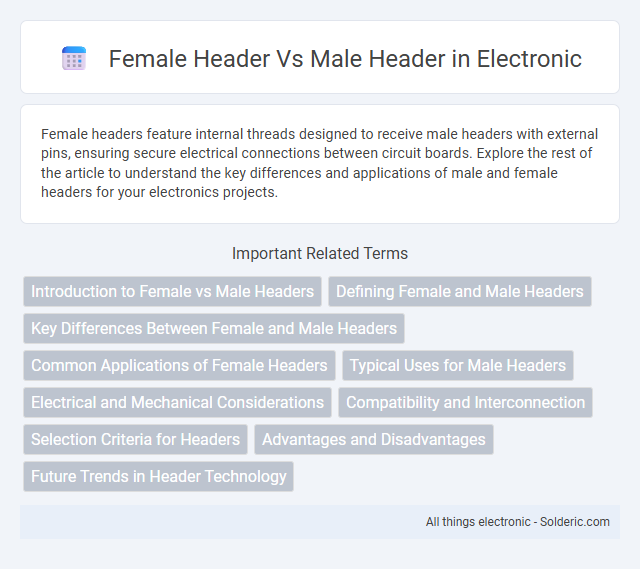Female headers feature internal threads designed to receive male headers with external pins, ensuring secure electrical connections between circuit boards. Explore the rest of the article to understand the key differences and applications of male and female headers for your electronics projects.
Comparison Table
| Aspect | Female Header | Male Header |
|---|---|---|
| Design | Receptive slot for connections | Protruding pins for insertion |
| Function | Receives and secures male connectors | Inserts into female connectors |
| Usage | Common in PCBs, wiring systems | Common in PCBs, wiring systems |
| Contact Protection | Contacts enclosed for safety | Exposed pins, less protected |
| Typical Shape | Socket-like, hollow | Pin-like, solid |
| Installation | Soldered or press-fit on PCB | Soldered or press-fit on PCB |
| Durability | Less prone to damage due to enclosed contacts | Pins can be bent or damaged easily |
Introduction to Female vs Male Headers
Female headers feature recessed connectors designed to receive male headers, which have protruding pins for insertion. This complementary design allows secure electrical connections on printed circuit boards (PCBs) and facilitates modular component assembly. Choosing between female and male headers depends on the application's mechanical stability, ease of maintenance, and signal integrity requirements.
Defining Female and Male Headers
Female headers are connectors designed with recessed slots or holes, allowing male headers, which feature protruding pins, to securely fit into them. The primary function of female headers is to receive and hold male pins to establish a stable electrical connection between components or circuit boards. Your choice between female and male headers depends on the specific application and the type of connection needed for your electronic project.
Key Differences Between Female and Male Headers
Female headers feature recessed or socketed openings designed to receive the protruding pins of male headers, ensuring secure electrical connections on printed circuit boards (PCBs). Male headers consist of exposed pin rows that plug into female connectors or sockets, facilitating easy insertion and removal during assembly or maintenance. The distinction in physical design between female and male headers directly influences compatibility, connection stability, and application in electronic device interfaces.
Common Applications of Female Headers
Female headers are widely used in electronics for connecting wires or components to printed circuit boards (PCBs) through reliable plug-and-socket interfaces. Common applications include microcontroller programming, sensor modules, and communication devices where easy disconnection and reconnection are essential. You can find female headers in Arduino shields, Raspberry Pi HATs, and other embedded systems requiring modular connectivity.
Typical Uses for Male Headers
Male headers are commonly used in electronic connectors to establish reliable connections between circuit boards and external devices or components. They serve as interface points in applications such as microcontroller boards, development kits, and sensor modules, enabling easy plug-and-play functionality. Typical uses include programming interfaces, peripheral connections, and prototyping setups where secure and accessible pin access is essential.
Electrical and Mechanical Considerations
Female headers offer secure electrical connections through recessed contacts that prevent accidental disconnection and enhance signal integrity, while male headers provide easy soldering points and mechanical robustness with exposed pins. Mechanically, female headers ensure a snug fit accommodating various pin sizes, reducing stress on PCB traces, whereas male headers facilitate straightforward insertion into sockets but are more susceptible to bending under mechanical strain. Electrical performance depends on contact resistance and durability, where female headers often yield lower contact resistance due to spring-loaded contacts, benefiting high-frequency and high-current applications.
Compatibility and Interconnection
Female headers provide recessed sockets that ensure secure connections by accepting male header pins, enhancing compatibility across various electronic components and circuit boards. Male headers with exposed pins are designed to fit precisely into female headers, allowing reliable interconnection in prototyping and development. Your choice between female and male headers should consider the need for secure mating, ease of assembly, and the specific layout requirements of your electronic project.
Selection Criteria for Headers
Selection criteria for female headers prioritize compatibility with corresponding male connectors, ensuring secure mechanical and electrical connections in applications like PCBs and wiring harnesses. Key factors include contact type, current rating, pitch size, and environmental resistance to vibrations and moisture. Male headers must align precisely with female counterparts, emphasizing dimensions, pin strength, and ease of insertion for reliable assembly and long-term durability.
Advantages and Disadvantages
Female headers offer secure connections by allowing male pins to be inserted, reducing the risk of bent or damaged pins during assembly, which enhances durability. Male headers provide easier visual inspection and quicker prototyping due to exposed pins but are more prone to damage from accidental bending or breakage. Choosing the right header depends on Your application's need for robustness versus ease of access and assembly efficiency.
Future Trends in Header Technology
Female headers are increasingly designed with enhanced durability and compatibility to support emerging high-speed data protocols such as PCIe 5.0 and DDR5 memory modules, reflecting future trends in header technology. Male headers are evolving with finer pitch and reinforced materials to improve signal integrity and withstand higher insertion cycles, critical for advanced computing and IoT applications. Innovations in both male and female header designs emphasize miniaturization and modularity to accommodate compact electronics and facilitate scalable, versatile system architectures.
Female header vs male header Infographic

 solderic.com
solderic.com